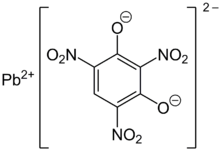Lead styphnate

| |
| Names | |
|---|---|
| Preferred IUPAC name
Lead(II) 2,4,6-trinitrobenzene-1,3-bis(olate) | |
| Other names
Lead 2,4,6-trinitrobenzene-1,3-diolate
Lead 2,4,6-trinitro-m-phenylene dioxide 1,3-Benzenediol, 2,4,6-trinitro-, lead(2+) salt (1:1) Lead tricinate Lead trinitroresorcinate Tricinat[1] | |
| Identifiers | |
3D model (JSmol)
|
|
| ChemSpider | |
| ECHA InfoCard | 100.035.703 |
| EC Number |
|
PubChem CID
|
|
| UNII | |
| UN number | 0130 |
CompTox Dashboard (EPA)
|
|
| |
| |
| Properties | |
| C6HN3O8Pb | |
| Molar mass | 450.288 g/mol |
| Density | 3.06 to 3.1 g cm−3 |
| Explosive data | |
| Shock sensitivity | High |
| Friction sensitivity | High |
| Detonation velocity | 5200 m/s |
| Hazards | |
| GHS labelling:[2] | |
   
| |
| Danger | |
| H200, H302, H332, H360Df, H373, H410 | |
| NFPA 704 (fire diamond) | |
| 330 °C (626 °F; 603 K) | |
| Safety data sheet (SDS) | Oxford MSDS |
Except where otherwise noted, data are given for materials in their standard state (at 25 °C [77 °F], 100 kPa).
| |
Lead styphnate (lead 2,4,6-trinitroresorcinate, C6HN3O8Pb ), whose name is derived from styphnic acid, is an explosive used as a component in primer and detonator mixtures for less sensitive secondary explosives. Lead styphnate is only slightly soluble in water and methanol.[3] Samples of lead styphnate vary in color from yellow to gold, orange, reddish-brown, to brown. Lead styphnate is known in various polymorphs, hydrates, and basic salts. Normal lead styphnate monohydrate, monobasic lead styphnate, tribasic lead styphnate dihydrate, and pentabasic lead styphnate dehydrate as well as α, β polymorphs of lead styphnate exist.
Lead styphnate forms six-sided crystals of the monohydrate and small rectangular crystals. Lead styphnate is particularly sensitive to fire and the discharge of static electricity. Long thin crystals are particularly sensitive. Lead styphnate does not react with other metals and is less sensitive to shock and friction than mercury fulminate or lead azide. It is stable in storage, even at elevated temperatures. As with other lead-containing compounds, lead styphnate is toxic owing to heavy metal poisoning.
Preparation[edit]
Although never substantiated, lead styphnate may have been discovered by Peter Griess (of Griess test fame) in 1874. In 1919, Edmund Herz first established a preparation of anhydrous normal lead styphnate by the reaction of magnesium styphnate with lead acetate in the presence of nitric acid.[4][3]
- {C6N3O8}MgH2O + Pb(CH3CO2)2 → {C6N3O8}PbH2O + Mg(CH3CO2)2
Structure[edit]
Normal lead styphnate exists as α and β polymorphs, both being monoclinic crystals. The lead centres are seven-coordinate and are bridged via oxygen bridges. The water molecule is coordinated to the metal and is also hydrogen-bonded to the anion. Many of the Pb-O distances are short, indicating some degree of covalency. The styphnate ions lie in approximately parallel planes linked by Pb atoms.[5][6]
Properties[edit]
Lead styphnate's heat of formation is −835 kJ mol−1. The loss of water leads to the formation of a sensitive anhydrous material with a density of 2.9 g cm−3. The variation of colors remains unexplained.[7] Lead styphnate has a detonation velocity of 5.2 km/s and an explosion temperature of 265–280 °C after five seconds.[8]
Applications[edit]
Lead styphnate is mainly used in small arms ammunition for military and commercial applications. It serves as a primary explosive used in firearms primers, which will ignite upon a simple impact.[9] It is similarly used in blank cartridges for powder-actuated nail guns. Lead styphnate is also used as primer in microthrusters for small satellite stationkeeping.[10]
References[edit]
- ^ ECHA, European Chemicals Agency "Archived copy" (PDF). Archived from the original (PDF) on 2014-10-22. Retrieved 2014-10-17.
{{cite web}}: CS1 maint: archived copy as title (link) - ^ GHS: GESTIS 490561
- ^ a b Boileau, Jacques; Fauquignon, Claude; Hueber, Bernard; Meyer, Hans H. (2009-04-15), "Explosives", Ullmann's Encyclopedia of Industrial Chemistry, Weinheim, Germany: Wiley-VCH Verlag GmbH & Co. KGaA, doi:10.1002/14356007.a10_143.pub2, ISBN 978-3527306732
- ^ J.R. Payne (1994). "Thermochmistry of lead styphnate". Thermochimica Acta. 242: 13–21. doi:10.1016/0040-6031(94)85003-8.
- ^ Pierce-Butler, M.A. (1984). "The structure of the lead salt of 2,4,6-trinitro-1,3-benzenediol monohydrate (alpha-polymorph)". Acta Crystallogr. 40: 63–65. doi:10.1107/S0108270184003036.
- ^ Pierce-Butler, M.A. (1982). "Structures of the barium salt of 2,4,6-trinitro-1,3-benzenediol monohydrate and the isomorphous lead salt (beta-polymorph)". Acta Crystallogr. 38 (12): 3100–3104. doi:10.1107/S0567740882010966.
- ^ Robert Matyáš; Ji í Pachman (2013). Primary Explosives. Springer Science & Business Media. doi:10.1007/978-3-642-28436-6. ISBN 978-3-642-28435-9. S2CID 199492549.
- ^ Hyman Henkin; Russell McGill (1952). "Rates of Explosive Decomposition of Explosives. Experimental and Theoretical Kinetic Study as a Function of Temperature". Ind. Eng. Chem. 44 (6): 1391–1395. doi:10.1021/ie50510a054.
- ^ Gray, Theodore (2009). "Flash Bang". Popular Science.
- ^ Daniel W. Youngner; et al. (2000). "MEMS Mega-pixel Micro-thruster Arrays for Small Satellite Stationkeeping". Honeywell Technology 14th Annual/USU Conference on Small Satellites. Archived from the original on 2021-03-10. Retrieved 2016-10-18.

